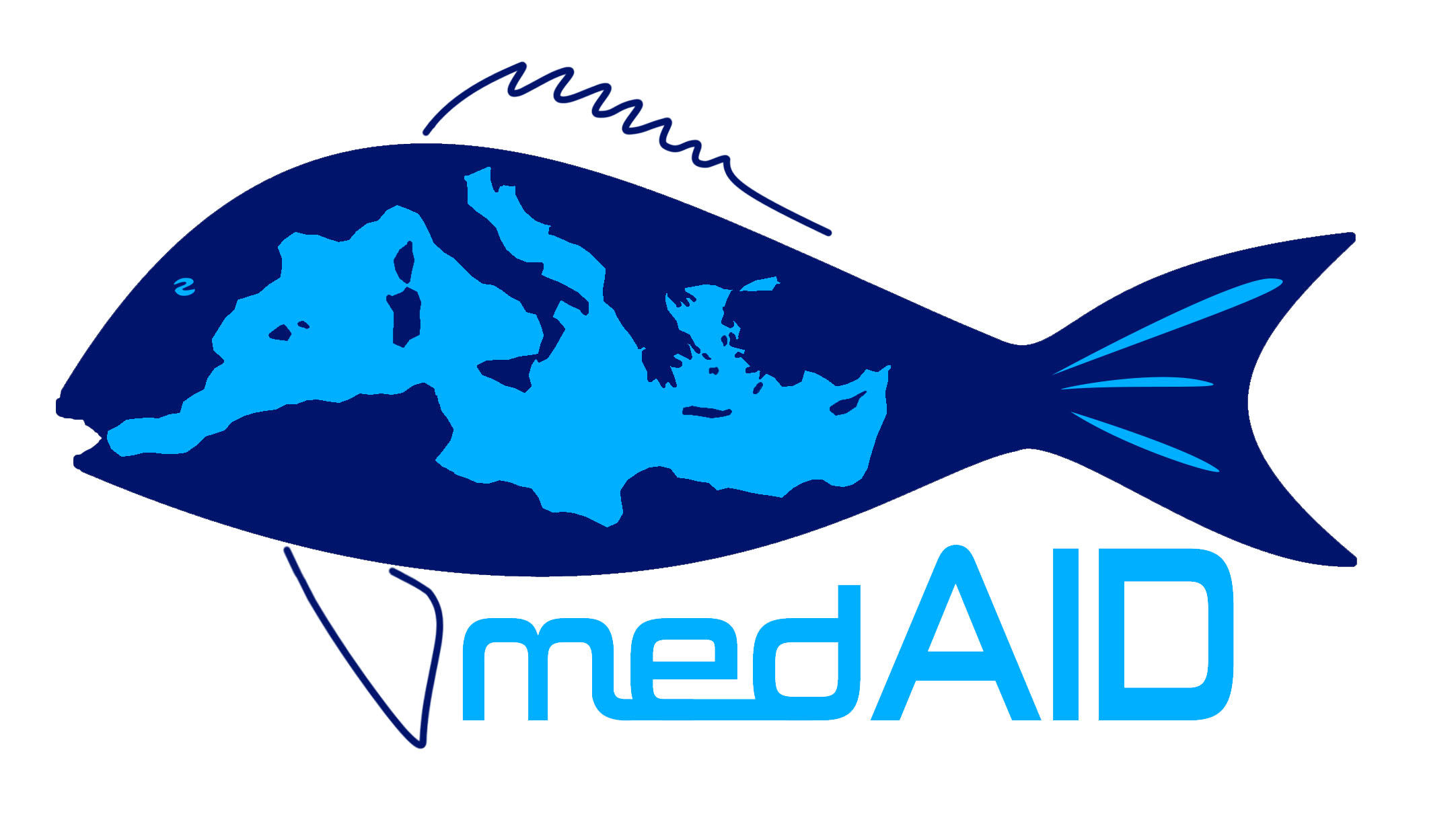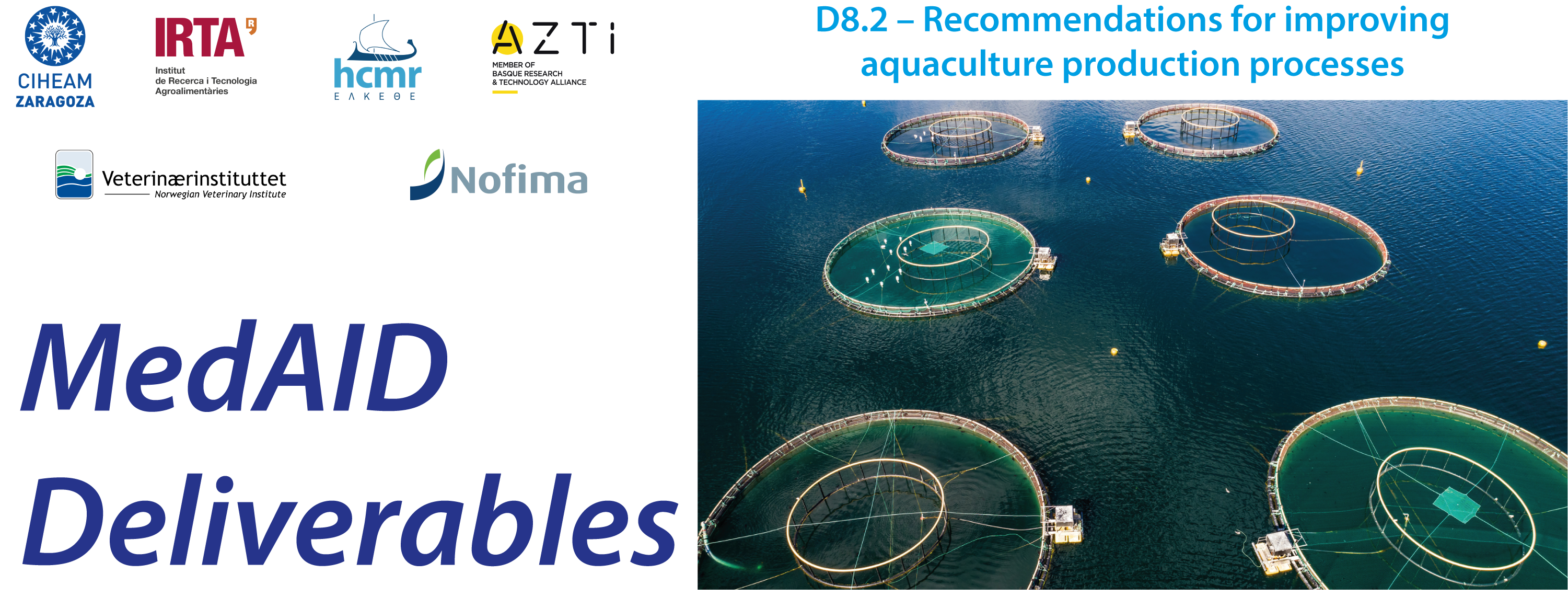Deliverable 8.2 consist of a compilation of the main outputs from MedAID project, regarding its transferability and applicability to all stakeholders of the Mediterranean marine fish farming sector, seabass and seabream, focusing on the assessment of the sector, productive (zootechnics, genetics, health) processes and the development of new products. It is, therefore, a collaborative work, where the 8.2 Task Leader, the Project Coordination Team, all Work package 1 to 5 leaders and related task leaders, worked together to synthetize their research results on sound based conclusions and recommendations.
Conclusions and recommendations from all MedAID work-packages were presented and discussed in seven thematic forums (webinars), followed by closed sessions with invited stakeholders. Thereafter, seven thematic factsheets were produced and distributed in MedAID Final Event held on 5th October during the Aquaculture Europe E2021 Conference held in Madeira. The factsheets, which are already available in the project Toolbox, constitute a key component of the communication and transference outputs of the project.
This reports constitutes the basis of an open access publication of MedAID (under preparation), that will also include the conclusions and recommendations from WP6 (Economics and marketing) and WP7 (Governance and social acceptability).
Thus, the main purpose of this work has been to give an answer to the main aim of MedAID Project (Improving the overall competitiveness and sustainability of the Mediterranean marine fish farming sector) by resetting a synthetic document compiling main conclusions and proposing recommendations to the sector. The recommendations are written in an easy understandable language as they are addressed to all stakeholders across the whole value chain of this sector and end users. Producers are the primary beneficiaries of these recommendations, however competent authorities, both with health and environment responsibilities, will find weighty support in this document. Public and private laboratories, feed producers and biotechnical companies will also find recommendations directly addressed to them, as well as product retailers and developers.
This deliverable is structured by Work-packages (from WP1 to WP5), including a summary article for each WP and a total of 39 recommendations, covering the Zootechnical aspects of the productive sector. It brings together the outcomes from WP1 (Holistic sustainability assessment of Mediterranean aquaculture) and the specific contributions from the disciplinary work packages related with zootechnics improvement (WP2), genetics and breeding (WP3), health management (WP4), and development of new products (WP5).
Working directly with marine farming firms, MedAID WP1 conducted a holistic assessment of the sector, where different typologies of farms and firms and main trends have been described. The husbandry practices that affect KPIsmost significantly were identified and a list of KIPs proposed. Moreover, through a Life Cycle Analysis the impact of the farms have been assessed, being feeds and energy the main environmental impacts identified. Infectious diseases and mortalities caused by them have been also identified as a main challenge to be faced by the sector. The scarcity of good, accessible and standardized data prove to be a major handicap for a better analysis of the whole sector and to provide the necessary knowledge which should constitute the basis of a good management and decision making processes. Thus, recommendations regarding the quality, typologies and data sharing have been proposed.
Recommendations to improve rearing conditions and feeding strategies (WP2) during the on growing stages include the choice of feed during situations of temperature changes and stress conditions. In addition, in cases of high rearing densities, low FM/FO feed is recommended since it had no effects on growth, feed efficiency or welfare. Regarding sustainability, one meal per day is enough for on growing fish; whereas, for juveniles (3-50 g) it is recommended to feed the fish 3 times per day. In seabream, eco-friendly diets are recommended, both for good growth, feed utilization, lower viscerosomatic index and to render a more environmentally sustainable production. When porcine plasma was used in seabream diets, an enhancement of the immune response was achieved. During critical periods of environmental changes or occurrence of pathogenic organisms in seabream culture, adding plant leaf extracts to feed proved to have prophylactic properties. The specifics of these diets are presented.
Water current and swimming behaviour have been found to affect fish growth. Seabream Juveniles swimming at 1 BLs-1 (body length/second) had better growth, uniformity, stress tolerance, robustness, energy mobilization and muscle building. A protocol for this training is provided.
Seabass larval rearing, at a temperature of 17.5˚C, is recommended to obtain higher survival rate and female percentage of faster growing fish.
In WP3, on Genetics and breeding, the first combined-species high-density SNP array for European seabass and gilthead seabream, “MedFish”, was constructed in collaboration with PerformFish project. The array enables efficient and accurate genotyping for genome-wide distributed SNPs. This will facilitate stock management, population genomics approaches, and acceleration of selective breeding through genomic selection.
Regarding fat and fatty acids traits, MedFish has proven to be reliable for estimating genetic parameters in both species. There is a large potential to increase the relative contents of omega-3 fatty acids in fillets of European seabass and of gilthead seabream by selective breeding. Similarly, total fat contents of both muscle and liver in seabass, and total fat content of muscle and weight of liver in seabream can be changed by selective breeding. Thus, these are candidate traits for breeding programs, as omega-3 content is beneficial for fish and human health, and fat traits are important for feed resource efficiency. Also for genetic breeding programs, the use of the Distell fat meter to measure the lipid percentage in fillets of European seabass has proved to be useful, since it allows non-lethal sampling with an affordable and portable device. Additional genomic information from genetic markers in the selection candidates and the tested sibs, from the MedFish array, is expected to lead to increased selection accuracy and genetic gains.
The MedFish array was very useful to determine population structure and genetic variability. It can discriminate between populations of wild (low levels of differentiation) and farmed (marked differences) fish, pointing at the importance of avoiding escapes, and showing to be a useful tool for the conservation of natural populations. MedFish can also be used to define the broodstock population size when starting new breeding programmes. Therefore, for future studies and genetic analyses by breeding companies, we recommend using the MedFish SNP array.
Genomic relationships data derived from fish typed with the MedFish SNP array are suitable for genetic and genomic analysis. For breeders, the use of genomic relationships has practical and analytical benefits over tracking fish pedigrees by separating families and using physical tagging.
Finally, the estimated genetic correlations for growth and fillet trait performance between East and West Mediterranean production sites of gilthead seabream indicate the existence of Genotype x Environment interaction for these traits. Genetic breeding programs and selction decisions need to take into account where the growing of these fish will take place.
For health management and diseases and fish welfare (WP4), very transversal recommendations are proposed involving stakeholders of both public and private sectors. To assess the risk of introduction and spread of relevant pathogens, a structured approach to identify critical control points and to evaluate their relative importance should be implemented. Thus, a risk assessment template and a Biosecurity scoring system are proposed.
The adoption of the diagnostic techniques described in MedAID Diagnostic Manual is highly recommended. Further strengthening diagnostic capacities by harmonizing competences would be an important improvement. Additionally to the need for capacity building, specialized continuous training is strongly demanded and crucial.
Communication actions in a permanent framework, engaging all stakeholders, are essential to acquire good information for disease management at regional level. Interactive tools (webinars, internet pools, live chats, etc.) should be used to improve and facilitate a better dialogue among stakeholders.
Based on the promising results of the VLP-based vaccine in experimental settings, it is recommended to continue the work towards registering the vaccine and make it available to the Mediterranean fish farms.
Developing a welfare certification scheme based on the operational welfare indicator (OWI) profiles for gilthead seabream proposed by MedAID, would be an important step forward for the industry.
Regarding Product development, market and consumer assessment (WP5), a comprehensive recommendations portfolio has been prepared. Information and inputs from the aquaculture chain stakeholders is essential to develop strategies to be able to change general awareness and to focus new products to new consumer niches and younger generations. It is recommended to target the “Adventurous” and the “Rational Food Consumers” in the promotion of new aquaculture fish products. Moreover, for the generation of new product ideas, it is advised to use qualitative research to incorporate consumers’ voices during the creative process and to launch the products according to the specific demands and needs of each targeted population. Since there is a market niche for aquaculture products, it is recommended to promote Mediterranean aquaculture to raise awareness of the high quality of the products.
To improve the processing of raw fish material in farms and production facilities, it is necessary to upgrade chilling during fish harvesting and handling procedures. Additionally, refined packaging (vacuum); and logistics to reduce the delivery time to reach the consumer are proposed.
Consumers have clear preferences for specific package designs, both in terms of visual and textual attributes. Therefore, our recommendation is to use the combination of attributes most preferred by consumers, identified within this study, to achieve higher product utility.
MedAID expects to impact positively on the Mediterranean fish farming sector by addressing this work directly to all stakeholders across the whole value chain. A collection of fact sheets, one per WP, has been prepared to summarize the project results and recommendations. The fact sheets are downloadable from the MedAID website and from the Toolbox. They constitute a key component of the communication and transference outputs of the project.
Access to the full deliverable

